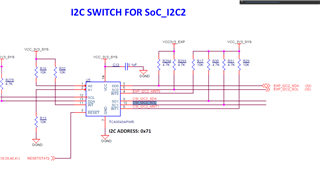Tool/software:
I am using the ti am62a7 evm board. right i connect the imx219 to SCO though J20 connector. There are no serdes and deserdes in this line.
Imx219 MIPI connect to SOC MIPI dricty。
and the setting of the device tree is below. The problem is that i can not using cmd "i2cdetect -y 2" to scan the i2c device in the i2c bus.
no any nod can be see after cmd ""i2cdetect -y 2”。 I can see that the evm board have a switch board tca9543 in the hardware design.
Why i can not use this i2c. I need to read some message form sensor in application function. can you share the step how i should do to implement the function
&main_i2c2 {
#address-cells = <1>;
#size-cells = <0>;
status = "okay";
i2c-switch@71 {
compatible = "nxp,pca9543";
#address-cells = <1>;
#size-cells = <0>;
reg = <0x71>;
/* CAM port */
i2c@1 {
#address-cells = <1>;
#size-cells = <0>;
reg = <1>;
ov5640: camera@10 {
compatible = "sony,imx219";
reg = <0x10>;
clocks = <&clk_imx219_fixed>;
clock-names = "xclk";
reset-gpios = <&exp1 13 GPIO_ACTIVE_HIGH>;
port {
csi2_cam0: endpoint {
remote-endpoint = <&csi2rx0_in_sensor>;
link-frequencies = /bits/ 64 <456000000>;
clock-lanes = <0>;
data-lanes = <1 2>;
};
};
};
};
};
};


